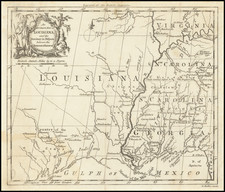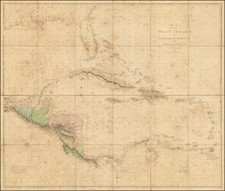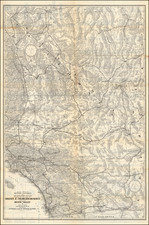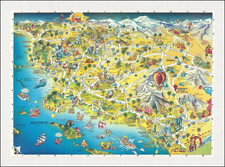The First Separate United States Government Map of Texas
William H. Emory's seminal Map of Texas and the Adjacent Regions, published in 1844, during the height of the Congressional debates on the annexation of Texas.
Emory's map was the first scientific attempt by the United States to accurately define the then Republic of Texas. William Emory had never been to Texas, so he created the map from a variety of sources that were available to him at the Corps of Topographical Engineers office in Washington. He relied most heavily on John Arrowsmith's 1841 map of Texas, along with nearly 20 other sources, which Emory lists at the lower left, including Humboldt, Pike, Long, Brown, Kearney, Fremont, Moore, Austin, Mitchell, Hunt & Randell, and Kennedy.
The map appeared in two formats, this example and a smaller version, published the same year. Streeter notes that it is not possible to determine which map preceded the other. Emory's map was the first US Government map to recognize the area claimed by the Republic of Texas, as established by the Texas Congress in December 1836. An example of the smaller version can be seen here: /gallery/detail/30375
During the Congressional debates on the annexation of Texas, one of the central questions was the establishment of its boundaries, both within the United States and with Mexico. Emory was charged with the preparation of this map, which is based largely upon Arrowsmith's map of Texas, but with significant improvements available to Emory from other sources.
Texas during final years of independency, encompassed much of New Mexico, including Santa Fe, with the panhandle boldly stretching nearly to the North Fork of the Platte River. Wheat states "this map exhibits the locations of the resettled Indian tribes west of the Mississippi-Missouri. A large, unnamed lake appears in place of Great Salt Lake... The boundaries of Texas, as here shown, follow the `Rio Bravo del Norte or Rio Grande' to its source (including Santa Fe, Taos and the New Mexican settlements east of that stream), thence north to 42° North Latitude, thence east to a point north of the source of the Arkansas, thence south to that source and southeasterly and easterly along that stream to 100 ° Longitude, thence south to the Red River, and thereafter as defined by treaty." In the area of the Llano Estacado appears the legend "According to Arrowsmith this tract of Country...is naturally fertile, well wooded & with a fair proportion of water."
A map of seminal importance to Texas collectors.











![[Southern California Views] Delightful Southern California, The Land of Sunshine and Bloom](https://storage.googleapis.com/raremaps/img/small/74862.jpg)
![[Southeastern Riverside County and Borrego Valley] Indio Special](https://storage.googleapis.com/raremaps/img/small/83488.jpg)

